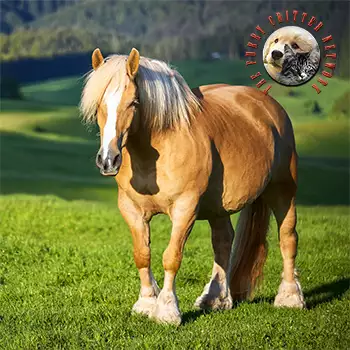History
The history of the Haflinger horse can be traced to medieval times when writings told of an Oriental race of horse found in the Southern Tyrolean Mountains of present day Austria and northern Italy. Many of the villages and farms in the Tyrol were accessible only by narrow paths requiring agile and sure-footed horses for transportation and packing. Artwork from the region from the early 1800's depicts a small noble chestnut horse with packs and riders traversing steep mountain trails. The first official documentation of the present day Haflinger (named for the Tyrolean village of Hafling) was in 1874 when the foundation stallion 249 Folie was born of the half-Arab stallion 133 El' Bedavi XXII crossed with a refined native Tyrolean mare. All modern purebred Haflingers must trace their ancestry directly to Folie through seven different stallion lines: A, B, M, N, S, ST, and W.
During the years of World War II, there was a significant shift in breeding practices, as pack horses were needed by the military and a shorter draftier Haflinger fit the bill. Following the war, the height and refinement of the breed has returned, with an emphasis on developing a small horse that was versatile for both riding and driving, with a strong constitution, a solid conformation with substantial bone, and an uncomplicated personality.
The majority of Haflingers are still imported from Austria even today. State studs own the stallions in Austria, carefully maintaining the quality of the breed. The first Haflingers arrive in the United States in 1958 when Tempel Smith of Tempel Farm, Wadsworth, Illinois imported them from Austria to begin a breeding program along with his imported Lipizzan horses.
The modern Haflinger is now found all over the world, active in such varied uses as draft work, packing, light harness and combined driving, western and trail riding, endurance riding, dressage and jumping, vaulting and therapeutic riding programs. Haflingers hold their own in competition with other breeds, often showing surprising athleticism and strength for their size.
Behavior
The uniqueness of the Haflinger lies, of course, in its golden chestnut coloring and long flowing white mane and tail. But more unique is the people-loving, willing and forgiving temperament that was established over centuries of living alongside and working with the mountain peasants, serving all purposes for all family members. Haflingers very simply became part of the family.
Function
Haflingers have many uses including light draft, harness work and various under-saddle disciplines such as endurance riding, dressage, equestrian vaulting and therapeutic riding.






